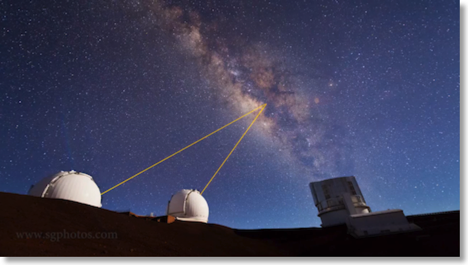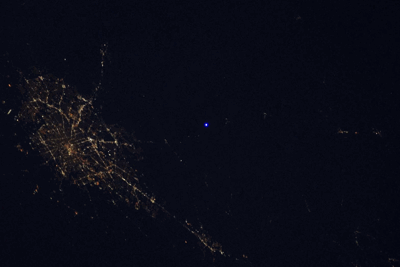Home
A comprehensive resource for safe and responsible laser use
US: Time-lapse video shows astronomy lasers being used at Mauna Kea
Sean Goebel, a graduate student in astrophysics, has produced a 3-minute time-lapse video showing observatories at Mauna Kea, Hawaii, shooting lasers into the night sky. By analyzing how the beam is distorted by the atmosphere, a telescope’s mirror can be counter-distorted in order to obtain sharper images for astronomers.

A still frame from the video. Two telescopes are simultaneously observing the same spot in the Milky Way, using lasers to help give a sharper image.
Goebel writes about the lasers:
“A typical laser pointer that you might use to point at stuff/exercise your cat is about 5 mW. That's five one-thousandths of a watt. Not a whole lot of power. And yet it's enough to blind airplane pilots. The lasers on the telescopes are in the range of 15-40 watts. The FAA calls a no-fly zone over the area when a laser is in use, and two people have to stand around outside in the freezing temperatures and watch for airplanes. Each of them has a kill switch to turn off the laser in case an airplane comes near.”
“Additionally, the telescope has to send its target list to Space Command ahead of time. Space Command then tells them not to use the laser at specific times, ostensibly to avoid blinding spy satellites. However, you could calculate the spy satellite orbits if you knew where they were at specific times, so Space Command also tells the telescope to not use the laser at random times when no satellites are overhead.”
To clarify, the FAA does not have a no-fly zone, but instead issues a “Notice to Airmen” or NOTAM about the laser operations. It is not illegal to fly over the area. Fortunately, at Mauna Kea’s location and altitude only a couple of flights per month fly at night within the laser-affected airspace over the mountain. At one telescope, planes get close enough to the beam to cause a shutoff once every year or twin.
Automated aircraft-detection systems are slowly being tested and phased in, since the cost of having humans watch the skies all night at Mauna Kea’s altitude (13,700 feet) is about $600,000 per year.
The video, “Mauna Kea Heavens”, can be seen at Sean Goebel’s website, which also has more information about adaptive optics lasers and how the video was made. Additional information on aircraft frequency and spotting techniques is courtesy Paul Stomski of the Keck Observatory. A story about Keck’s aircraft protection system appears online in Ascend magazine.
World: Discussion of how lasers damage imaging sensors
This is being posted because some persons may find the ideas presented to be useful. An additional resource is a page at the International Laser Display Association, about damage to cameras at laser light shows.
From Image Sensors World
US: Amateur astronomers illuminate International Space Station with spotlights and 1-watt laser

Two-frame animated GIF showing bright and dim light from the Lozano Observatory (center) near the city of San Antonio (left). North is to the right in this photo from the International Space Station, taken by astronaut Don Pettit. Click on photo for a larger version.
The spotlights were flashed at the ISS by holding plywood sheets in front of the lights every two seconds. This procedure can be seen in the video below.
The animated GIF above shows a bright blue light alternating with a dim light. The bright light is almost certainly from the spotlights. The bluish tint may be an artifact of oversaturating the camera’s sensor. Astronaut Don Pettit reported that the bright light appeared white, and the dim light appeared blue. He wrote “We could only see the laser when the white light was off and not all the time.” (E.g., the white spotlights overpowered the blue laser.) He added, “It was like there were tracking issues with the laser to keep it on target.”
The dim light in the animated GIF may be the laser only, or it may be light from the spotlights that wasn’t fully blocked by the plywood sheets. The astronomers will be working with Pettit, trying to pin down exactly how visible the laser light was.
Worldwide: Concern over laser dazzling of satellites
“There are lasers used to hit satellites, it’s called dazzling, and it’s a show of force. There are a handful of countries that can do it. China dazzles U.S. and French satellites in low earth orbit not often, but regularly. What if a laser hits them, maybe lingers too long? A show of force can actually damage the satellite, knocks out some sensitive equipment. If that happens, and it’s from China, is that an act of war? What do you do? Political leaders have to be briefed on this. They have to make an effort to avoid escalation.”
From an interview in the Santa Barbara Independent conducted by Kevin Zambrano
US: Report says Iran blinded CIA satellite with laser
This was the only laser-related information in a December 15 2011 article that was otherwise about Iran tricking a U.S. drone into landing in Iran by jamming its GPS position signals.
From the Christian Science Monitor; the laser paragraph was on page 2 of the online story. See also an October 2011 Washington Post story analyzing a politician’s claim that China blinded U.S. satellites in 2006.
.